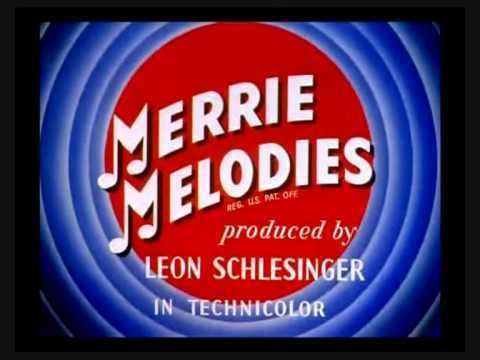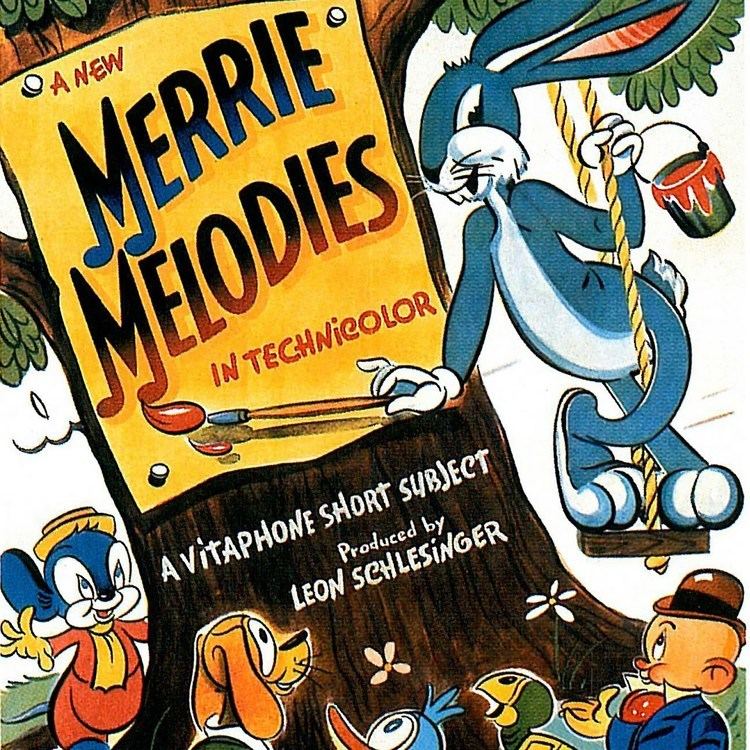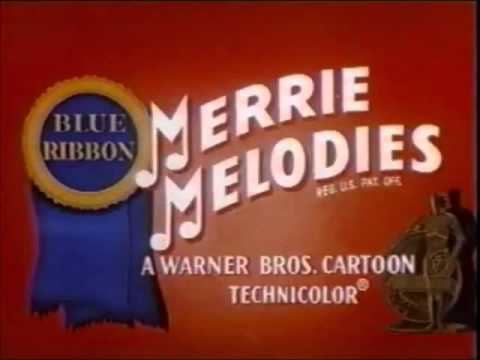Merrie Melodies
6 /10 1 Votes
Duration Language English | Country United States | |||||||||||||||||||||||||||||||||
 | ||||||||||||||||||||||||||||||||||
Director Tex AveryBob ClampettArt DavisFriz FrelengHugh HarmanRudolf IsingChuck JonesRobert McKimsonFrank TashlinMore... Release date 1931–1969 (original)1988 (revival) | ||||||||||||||||||||||||||||||||||
The looney tunes show merrie melodies we are in love hd lyrics
Merrie Melodies is an American animated series of comedy short films produced by Warner Bros. between 1931 and 1969, during the golden age of American animation. As with its sister series, Looney Tunes, it featured some of the most famous cartoon characters ever created; including Bugs Bunny, Daffy Duck, Porky Pig and Elmer Fudd.
Contents
- The looney tunes show merrie melodies we are in love hd lyrics
- Background
- Blue Ribbon reissues
- Inducted into the National Film Registry
- Academy Awards for Best Short Subject Cartoon
- Academy Award nominations
- References

Merrie Melodies was originally produced by Harman-Ising Pictures from 1931 to 1933, and then Leon Schlesinger Productions from 1933 to 1944. Schlesinger sold his studio to Warner Bros. in 1944, and the newly renamed Warner Bros. Cartoons continued production until 1963. It was outsourced to DePatie–Freleng Enterprises and Format Films from 1964 to 1967, and Warner Bros. Cartoons resumed production for its final two years.

Three of the Merrie Melodies films (Tweetie Pie, Speedy Gonzales and Birds Anonymous) won the Academy Award for Best Animated Short Film and another three (Duck Amuck, One Froggy Evening and What's Opera, Doc?) have been inducted into the National Film Registry of the Library of Congress.

In 2013, TV Guide ranked the Warner Bros. Cartoons (ranked as Looney Tunes) the third Greatest Cartoon of All Time (out of 60).
Background
Producer Leon Schlesinger had already produced one cartoon in the Looney Tunes series, based on music, and its success prompted him to try to sell a sister series to Warner Bros. His selling point was that the new cartoons would feature music from the soundtracks of Warner Bros. films and would thus serve as advertisements for Warner Bros. recordings and sheet music. The studio agreed, and Schlesinger dubbed the series Merrie Melodies. Walt Disney Productions had already scored with their Silly Symphonies. Since cartoon production usually began with a soundtrack, animating a piece of music made it easier to devise plot elements and even characters.
The origins of the Merrie Melodies series begin with the failure of a live action series of musical shorts called Spooney Melodies, which featured popular songs of the day. These shorts were basically an early type of music video that included segments with a popular artist singing along with appropriate background sequences. Warner Bros. wanted to promote this music because they had recently acquired (in 1930) the ownership of Brunswick Records along with four music publishers for US $28 million. Because of the success of their Looney Tunes series, Warner Bros. decided to develop a new series of animated musical shorts called Merrie Melodies. Hugh Harman and Rudolf Ising led the development. It was meant to be a series of musical cartoons that featured hit songs of the day, especially those then owned by Warner Bros. and featured in their musical films. In 1931, many of the shorts featured the orchestra of Abe Lyman, one of the most famous band leaders of his day.
The first cartoon of the new Merrie Melodies series was Lady, Play Your Mandolin!, released in 1931. Ising attempted to introduce several characters in his Merrie Melodies films, such as Piggy, Foxy, and Goopy Geer. Eventually however, the series continued without any recurring characters. The shorts proved to be enormously popular with the public. In 1932, a Merrie Melodies cartoon, entitled It's Got Me Again!, was nominated for the first Academy Award to be given for animation.
When Harman and Ising left Warner Bros., in 1933, they took with them all rights to the characters they had created. Leon Schlesinger had to negotiate with them to keep the rights to the name Merrie Melodies, as well as for the right to use the slogan, So Long Folks, at the end of the cartoons. In 1934, Schlesinger produced his first color Merrie Melodies shorts, Honeymoon Hotel and Beauty and the Beast, which were produced in two-strip Cinecolor (Disney then had exclusive animation rights to the richer three-strip Technicolor process). Their success convinced Schlesinger to produce all future Merrie Melodies shorts in color, using two-strip Technicolor. Looney Tunes continued in black and white until 1943. In 1936, the cartoons began to end with the slogan "That's all Folks!" which had previously only been used on the Looney Tunes series. The old slogan "So Long, Folks!" was completely abandoned at this time. The same year, Merrie Melodies began using the bulls-eye opening and closing title sequences (in 1942, Looney Tunes would use the same titles, usually in thicker rings). Also by 1936, Disney's exclusivity on the three-color Technicolor process was lifted, allowing Merrie Melodies a full color palette for the first time, hence the use of the blue concentric rings (as a technical test) for the rest of the 1935 - 36 season and the 1936 - 37 season. The Warner Bros. shield was later that year changed to cyan before definitely changing back to red in 1938.
Contractually, Merrie Melodies cartoons were obligated to include at least one full chorus from a Warner Bros. song. Warner Bros. requested that these songs be performed by name bands whenever possible, but this lasted only through the first few shorts. The policy annoyed the animators of Merrie Melodies, since the songs often interrupted the cartoons' momentum and pacing (the 1938 Merrie Melodie A Feud There Was, for example, sarcastically uses the obligatory musical number as a shift in the action, with the lead characters singing the number into a KFWB microphone and ceding the mike to an announcer who reads a commercial). By 1939, the animators had been released from this obligation, and the Merrie Melodies shorts came to resemble more closely the black-and-white Looney Tunes series. In addition, several new characters were created to (initially) appear exclusively in the Merrie Melodies series, such as Egghead (who became Elmer Fudd), Inki, Sniffles and even Warner Bros.' most popular cartoon star; Bugs Bunny.
In 1942, Schlesinger began producing Looney Tunes in color as well, and the two series became virtually indistinguishable except by their theme music and opening titles – in addition, characters once exclusive to one series began regularly appearing in the other as well. In 1944, the studio went to an all-color schedule; though for the first year of this, Bugs still appeared mainly in the Merrie Melodies series (not appearing in a Looney Tunes cartoon until the end of August), whereas Daffy Duck and Porky Pig (who each appeared in a few Merrie Melodies prior to mid-1942) appeared mainly in Looney Tunes that year. It was not until 1945 that the two series appeared completely indistinguishable, and that Bugs appeared in more Looney Tunes than Merrie Melodies.
By 1937, the theme music for Looney Tunes was "The Merry-Go-Round Broke Down" by Cliff Friend and Dave Franklin and the theme music for Merrie Melodies was an adaptation of "Merrily We Roll Along" by Charles Tobias, Murray Mencher and Eddie Cantor (the original theme was "Get Happy" by Harold Arlen, played at a faster tempo). This continued until 1964, when the WB cartoon logos were modernized, and "The Merry-Go-Round Broke Down" became the theme for the Merrie Melodies as well. When the studio went to full color, even the animators themselves did not make any creative distinction between the two series, as evidenced in an interview quote from director Friz Freleng, "I never knew if a film I was making would be Looney Tunes or Merrie Melodies, and what the hell difference would it make, anyway?". The last Merrie Melodies cartoon was Injun Trouble released in 1969. The Merrie Melodies theatrical cartoons didn't start up again until 1988 with only two cartoons made, The Night of the Living Duck (1988) and (Blooper) Bunny (1991), the former got a theatrical release through the compilation film Daffy Duck's Quackbusters (1988) and the latter was originally supposed to be released in 1991 but got shelved for several years until it premiered on Cartoon Network on June 13, 1997.
Blue Ribbon reissues
Beginning in late 1943, WB, in a cost-conserving effort, began to reissue its backlog of color cartoons under a new program that they called Merrie Melodies "Blue Ribbon" classics. For the reissue, the original front-and-end title sequences were altered. The revised main title card began with the "zooming" WB logo, followed by the title logo set against a background featuring a "blue ribbon" (hence the re-release program's title) and a Grand Shorts Award trophy, followed by the name of the cartoon. This revised title sequence eliminated the opening technical credits. The end title card was also revised (except for the 1943 - 44 season and half of the 1944 - 45 season of reissues, such as A Wild Hare and I Love to Singa when Schlesinger was still producing the cartoons), replacing the original versions.
The revised title sequences were edited right into the original negative, thus the original title sequences were cut away and possibly scrapped. Some of these same revised "blue ribbon" reissues can still be seen on television today. For example, the "Blue Ribbon" version of the Bugs Bunny short A Wild Hare was retitled The Wild Hare for reissue, along with some slight subtle edits (the original unaltered version has been released on LaserDisc, DVD and Blu-ray Disc).
